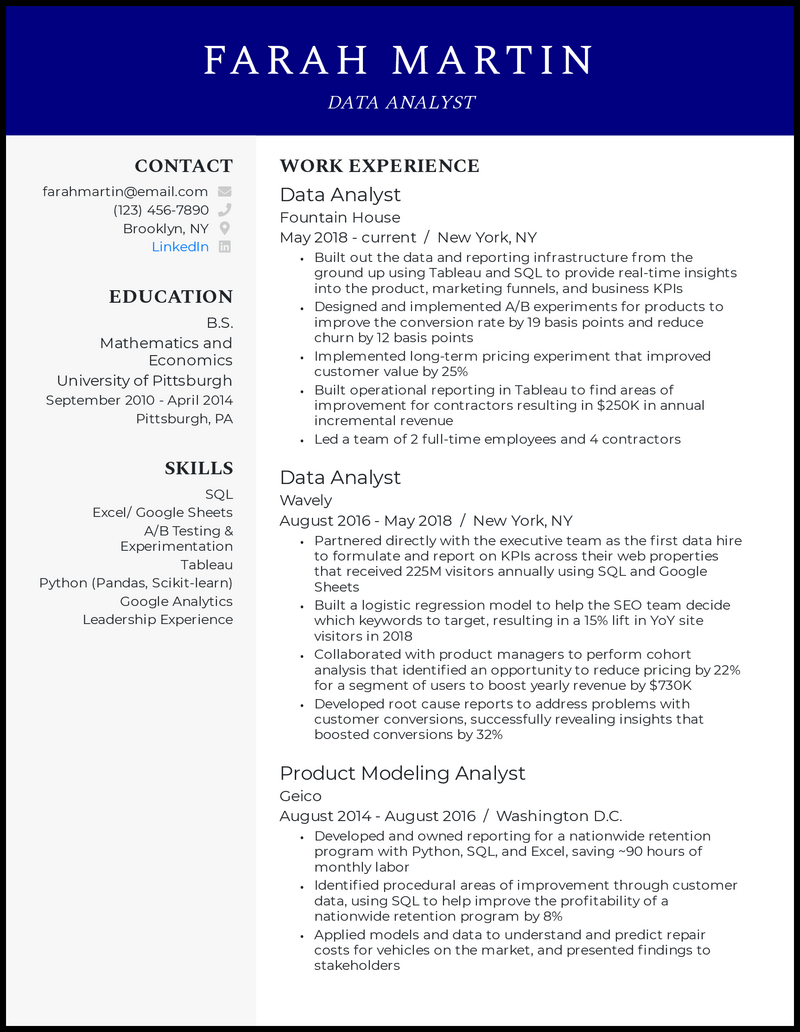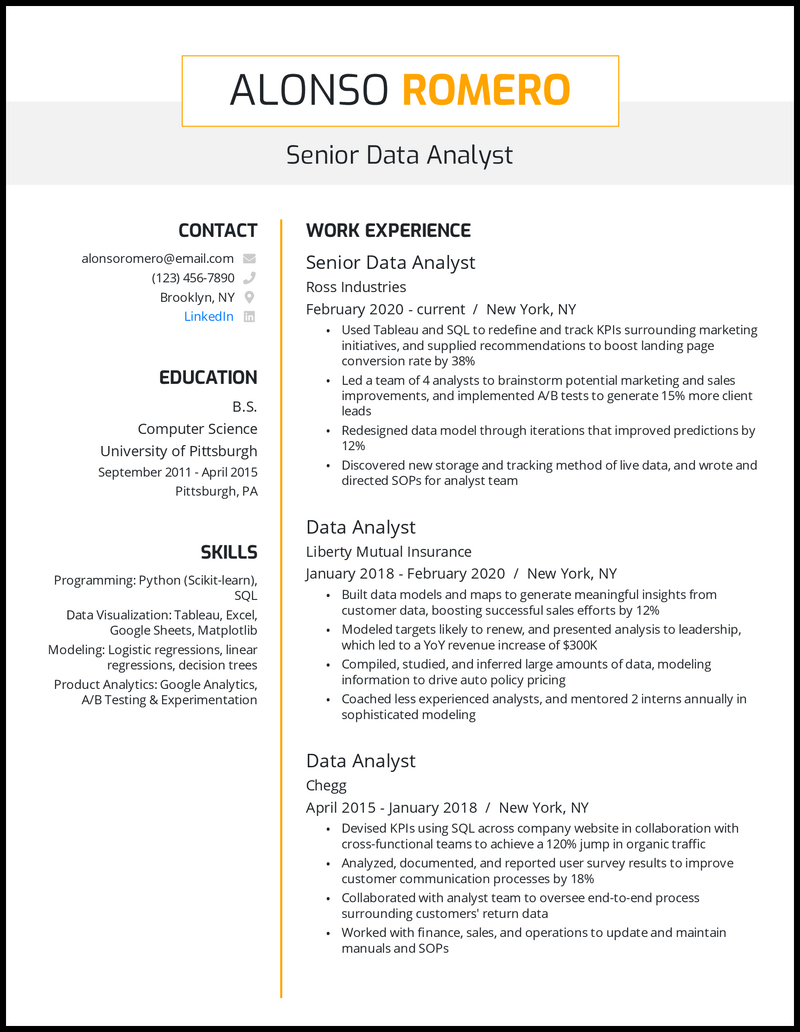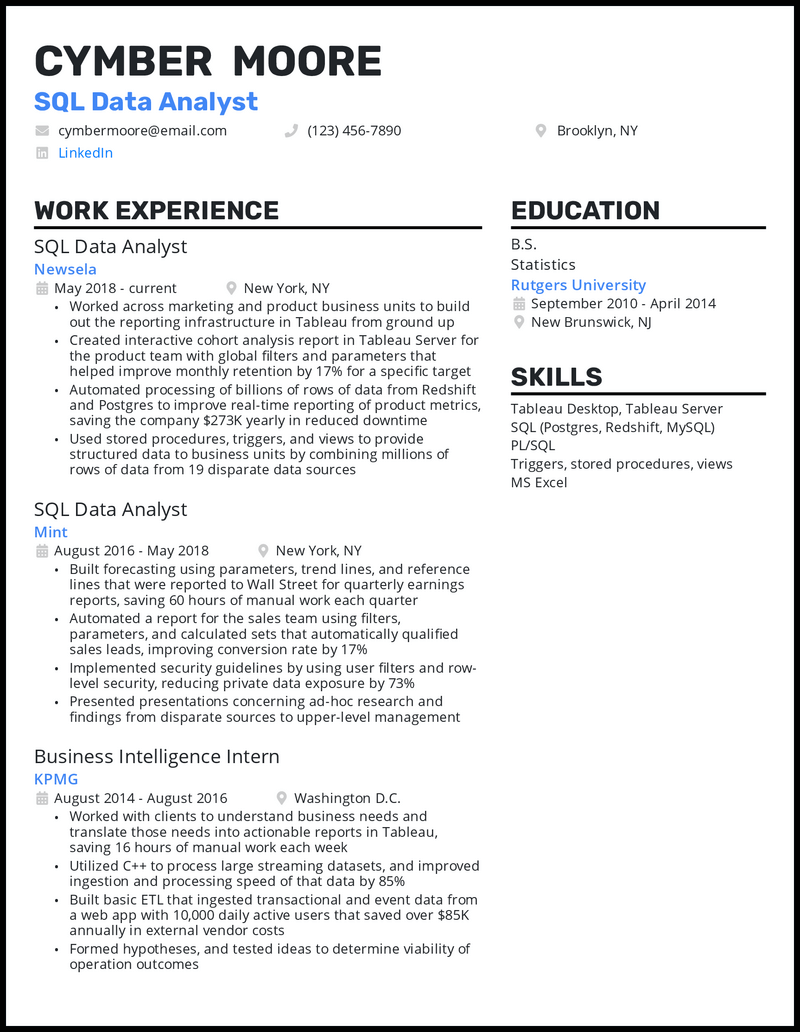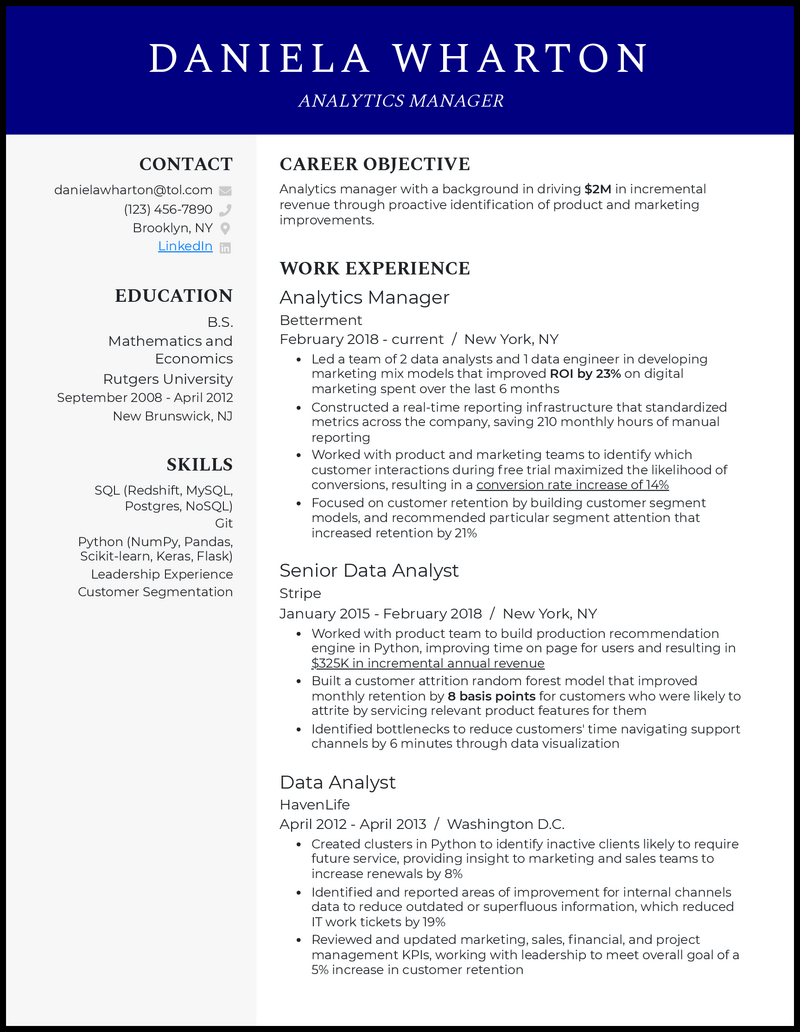The number of data analysts is expected to grow by 25 percent between 2020 to 2030, coupled with the increase in pay transparency laws making this the ideal time to get a data analyst job.
Fun fact: before starting BeamJobs, one of our founders worked as a data analyst for six years. With his guidance, we’ve reviewed many data analyst resumes to figure out what helps data analysts get more interviews.
Building a resume and data analyst cover letter is the hardest part of this process. To inspire you, we chose 33 top data analyst resume samples for different career stages.
Our data analyst resume examples are proven to help you put your best foot forward to get the job you’ve always wanted in 2025.
Why this resume works
- Because mid-level roles exist in a non-junior, non-senior-type limbo, it’s crucial to identify and exemplify every bit of experience possible for your data analyst resume. If you have a target company or niche in mind, pay special attention to the individual job description, looking for keywords, the mission statement, and even the company culture.
- Once you know what the employers are looking for, you can include directly applicable keywords and matching language in your work experience bullet points (provided the keywords truly describe you!)
- After you’ve determined the content and matching keywords for your bullet points, add in any quantifiable metrics that can showcase your experience and help prove your merit.
Why this resume works
- If you lack paid work experience in a field, consider it an opportunity to include personal projects on your data analyst intern resume where you demonstrated skills relevant to the position you’re applying to.
Why this resume works
- Unsure how to make a resume? No problem! Start by using a solid resume outline to help you get a feel for what a resume looks like, then add your experience and skills one at a time.
- As an aspiring professional, you’ve got options for showcasing your skillset on your entry-level data analyst resume.
- The first is to demonstrate programming, testing, modeling, and data visualization competency by building well-designed projects that solve real problems through code.
- The key here isn’t reinventing the wheel but creating something dynamic and unique that can’t be easily replicated with a few Google searches and a video tutorial.
- The second option is to invest time and effort into internships. They’re a fantastic way for an aspiring degree-holder to gain on-the-job experience.
- Some internships require a completed degree before starting. Although this is becoming more uncommon due to online coding trade schools, do some research regarding markets and locations.
Why this resume works
- An easy way to demonstrate your analytical abilities and eagerness for the job is by including a resume objective.
- To impress hiring managers, include programming languages you’re familiar with, what you hope to do at your future job, and some of your passions within the field.
- Your entry-level risk adjustment data analyst resume needs to demonstrate your skills in data gathering, interpretation, and presentation competencies. To get that kind of experience, you can go about it a couple of ways:
- The first is to build well-designed scalable projects that solve real problems through code. So, if you haven’t done any projects, now’s the time to start! Projects are a great way to fill your resume if you don’t have work experience.
- The second option is to get an internship. Some internships require a degree, but online coding trade schools and boot camps are becoming more popular and feasible.
Why this resume works
- While starting out with your junior data analyst resume, you might feel like your professional history looks a bit sparse—but that’s okay! You can boost your credibility and add intrigue by referencing an impressive project you might have tackled.
- Even when a project wasn’t part of a previous job, be as specific as you can by including examples or metrics to show your impact!
- Ensure that any projects or accomplishments such as internships, classes, or volunteer initiatives, relate directly to the job role.
- Including a career objective can also help bulk up your resume with information about what you can offer.
- Examples and quantifiable metrics of success can make any resume outshine the competition: And they’re extra important for junior data analysts!
- Since data analysis focuses so heavily on numbers like profits and improvement percentages, include plenty of these to back your credibility.
Why this resume works
- As a senior data analyst, the need for a comprehensive career objective dwindles. Your senior data analyst resume should heavily focus on work history, excellent KPIs, and leadership.
- Highlight a lengthy career in data analyst roles with quantifiable data from multiple sources, jobs, leadership, and mentoring.
- With experience comes a whole host of skills; however, don’t list every ability you have in your resume skills section.
- Only include highly relevant ones like Python, SQL, Tableau, and Excel with additional modeling, data visualization, and product analytics keywords.
Why this resume works
- Including a resume summary on your senior insurance data analyst resume helps you highlight your lengthy career with quantifiable data from various sources and can help you land an interview by setting you apart from more novice competition!
- We recommend structuring work history in reverse-chronological order, as it lists your most recent jobs first, followed by older positions.
- This resume format allows the employer to read your work history like an unfolding story, but with the punchline first.
- As an experienced insurance data analyst, you have a lot of skills. However, refrain from overwhelming recruiters with irrelevant abilities.
- Only list skills on your resume that truly apply to the role at hand; you’ve got limited space—don’t waste it.
Why this resume works
- Employers will naturally expect you to include a good amount of work experience so make sure you’re using a design that can handle longer bullet points.
- The Standout template is basically your best friend since it lets you add your education, skills, and work experience without cramming everything. And to be sure that you’ve included all the crucial sections, parse your resume and add anything you may have missed.
Why this resume works
- Three solid years—that’s how long you’ve been sorting through data and helping your employers solve problems. However, letting the recruiter know that is not enough to get you the job. You need a data analyst 3 years experience resume showing you can actually make things happen to even stand a chance.
- Let’s put it in another way: show off your wins as a junior data analyst to assure potential employers they are betting on the right horse. For example, Harper talks about using Tableau to whip up and oversee dashboards to keep tabs on KPIs for more than 50 clients across multiple countries.
Why this resume works
- Sure, manipulating data is one of your fortes. But if you really want to win over the potential employer, you must prove you’re a well-rounded professional. That should propel showcasing soft skills in your Microsoft data analyst resume at the tippy top of your long list of priorities.
- Essentially, make an effort to put competencies like initiative, leadership, and problem-solving in the limelight. One of the secrets? Kick off your bullet points with the right action words. Take managed in Madison’s resume, for instance, and boom, that screams leadership.
Why this resume works
- A vast majority of hiring managers are nuts about candidates who are all in, which is why we’re all for highlighting relevant certifications in your Snowflake data analyst resume.
- For example, rocking a SnowPro Advanced Data Analyst certification isn’t just about flash—it says you are in for the long haul and are already stacking your arsenal with the skills and knowledge to complete the journey. That aside, it shows you’re in tune with industry standards, which puts you several steps ahead of the pack.
Why this resume works
- Trust us; nothing screams “Unfit applicant” louder than an avalanche of grammatical mistakes in your freelance data analyst resume. Follow Corbin’s lead and take a fine-tooth comb to your sales pitch, cleaning out any oversights that could torpedo your job chances.
- Slip-ups like typos, awkward phrases, or incorrect word choices (think “quarried” when you mean “queried” can land you in big trouble when you’re job hunting. After thorough proofreading, you can rid your masterpiece of those nasties using an AI-powered resume fixer.
Why this resume works
- Here’s the deal: You can’t just go around saying you help companies extract important employee data. You’ve got to show how effective this data is and how it’s helped firms in your past roles.
- Don’t send your HR data analyst resume out the door without adding hard-hitting numbers like “Formulated 2 advanced Microsoft Excel models… saving $13,941 in extra talent acquisition costs.” This way you’re not just speaking data, you’re displaying its monetary value!
Why this resume works
- This is one of the times when you want to focus more on a single skill to beat the competition. Sure employers want to know how good of a data scientist you are, but not without knowing how you can specifically use Power BI in corporate settings.
- Take your Power BI data analyst resume up a notch by highlighting any Power BI-based task you’ve led and the kind of impact it created for the company.
Why this resume works
- Bullet points in an Excel data analyst resume can be lengthy so make sure you’ve got the right amount of spacing between points to avoid giving employers an eye exam.
- Use the Standout template from our library to have enough space for adding all your skills, experience, and education. Include as many skills as you can in your experiences to prove you can always switch from Excel to other tools to extract and refine data.
Why this resume works
- Here’s an eye-opener: recruiters will scan resumes for a mere 6 seconds. Outrageous, right? Even if your Python data analyst resume happens to be the final piece on the stack and the hiring manager has all the time in the world, drawing attention to your success record of delivering results can crank up your appeal.
- Take a leaf from how William bolds and underlines reducing vehicle downtime by 27% and saving $128K monthly in yearly maintenance costs. Similarly, identifying trends and revenue growth opportunities that increased monthly sales by $101,972 is sure to catch the hiring manager’s eye. You could italicize instead of underlining but let the bold stay.
Why this resume works
- As much as your technical skills are vital to the success of your data governance analyst resume, you require more than that for your application to stand out. Take Aisha’s piece, for example, and see how she underscores her ability to save time and money.
- For your case, achievements that touch on cutting costs (cue: saving 13% in infrastructure expenses) and reducing process times (cue: saving 12 hours per week) would propel your candidacy to early success.
Why this resume works
- You may try, but a data quality analyst resume without a solid backing of tools and software competencies will be shunned by recruiters.
- Therefore, to have a soft landing for your application, don’t spare any skills that you feel are relevant to the job—either in your resume or letting an AI cover letter generator have a go at your application. Including your mastery in Talend Data Quality, QuerySurge, Informatica Data Quality, and more would be a great strategy to impress potential employers.
Why this resume works
- If being good with numbers under pressure is your thing, then you’re already halfway done! All that’s left is sprinkling your financial data analyst resume with some clear work metrics.
- List down the best financial institutions like Citi and Deloitte that you’ve worked for (even for a position as low as an intern or volunteer!) and you’ll be on every employer’s hiring list. It’s also a great idea to list any certifications you hold such as “Chartered Financial Analyst.”
Why this resume works
- Who says all data analysts have to start out as programmers? Even a small beginning such as a data entry clerk is a good addition to your R data analyst resume if it’s relevant.
- Follow John’s lead and state how you’ve worked with data and specifically (very important!) on R-based frameworks. Keep things simple and vary how you’ve helped each company during your tenure.
Why this resume works
- Your Alteryx data analyst resume will benefit from assimilating clear examples of your work with abstract skills.
- For instance, rather than simply listing your proficiency in data manipulation, describe how you leveraged your expertise in this area to free up storage space and increase efficiency for the organization.
Why this resume works
- When interpreted with a keen eye, big data can yield surprisingly impactful insights for corporations. But in order to make a difference, these inferences need to be communicated clearly.
- Take your big data analyst resume to the next level by demonstrating your prowess in presenting actionable analyses to key organizational stakeholders.
Why this resume works
- Even a candidate with years of industry experience can optimize their clinical data analyst resume with an additional certification. Make sure recruiters can easily spot that you’re a Certified Clinical Data Analyst (CCDA) to add an extra level of credibility to your background.
Why this resume works
- As a creative data analyst, your ability to help numbers tell a story sets you apart. Emphasize your dual skillset in analysis and visualization by showing how data and marketing intersect in your past experience.
- This will demonstrate to hiring managers that you bring a fresh perspective to the table—always a plus on a creative data analyst resume!
Why this resume works
- For a leading role, you want to show growth throughout your work experience and demonstrate it as quickly as possible. Opening with active terms like “led” and “spearheaded” can show your ambition from the get-go.
- Formatting your resume in reverse-chronological order is always a good way to wow recruiters with your most recent experience and relevant accomplishments. Put your best foot forward!
- Make sure your examples of leading roles are also as well-rounded as possible since this is another quick way to demonstrate how much you’ve learned throughout your career.
- Since lead data analyst roles are so focused on details and critical thinking, make sure you highlight these areas, too!
- A lead data analyst resume can’t get away with vague claims alongside a hefty professional background—you’ve got to offer proof!
- Use solid, quantifiable metrics like improvement rates and dollar-amount company savings to back up your achievements.
Why this resume works
- Your career choices might not always reflect what you chose to study in college. But when that is the case, you should let a recruiter know!
- For instance, if you’ve completed a B.S. in Health Care Informatics, it means you’ve spent an extensive period of time learning how to analyze and interpret healthcare data and information—which is what most recruiters will be looking for in your healthcare data analyst resume.
Why this resume works
- Use a resume format that includes the work experience in reverse-chronological order.
- By doing so, you put your most recent accomplishments at the very top of your business data analyst resume—which is where a recruiter or your next potential employer is going to look first.
Why this resume works
- Combining marketing and data analysis requires a lot of skill, and we know it can be hard to convey all your credentials on your marketing data analysis resume. That’s where you can include relevant certification to do the talking for you.
- For instance, if you’ve completed a Professional Certified Marketer (PCM) certification, it’s clear you understand the nuances required to be a marketing professional. Then, you can use the work experience bullet points to focus on the analysis aspect of your role.
Why this resume works
- The career objective on your AWS data analyst resume gives you a little room to talk about your professional skills and aspirations and how they integrate with the role you’re applying to.
- You only have a couple of sentences to do so, but it’s still a powerful way to tell a recruiter exactly what you bring to the table and what they stand to gain if they hire you.
Why this resume works
- Your SQL data analyst resume needs to be powerful regardless of you how much experience you have. Even if you only have internships, choose your work experience bullet points wisely since customizing your resume is the best way to catch an employer’s attention (and pass the ATS scan).
- Start by analyzing the requirements in data analyst job descriptions to get an idea of what employers require.
- Speaking of customization, commonly interchangeable titles such as “data analyst,” “data developer,” and “data engineer” have virtually identical responsibilities. Despite their similarities, recruiters will respond best if your previous titles match the job for which you’ve applied.
- Speak with your current manager if you’re anxious about changing position titles. Always err on the side of caution, and ask for permission instead of forgiveness.
Why this resume works
- Analytics management is complicated and highly technical, but your data analytics manager resume needs to make your credentials and qualifications easy to understand.
- Making your resume easy to read can be as simple as using a resume template, but it also means condensing your bullet points as much as you can, including metrics to boost your credibility quickly, and leaving just enough white space to make it a breeze to skim.
- When updating your resume skills list for each job, there are two primary sources of data you must collect, analyze, and apply.
- The first is the job description’s list of required skills. The second source is a job board advertising analytics manager roles in a specific geographic location.
- Both sources give you a general idea of what you need to emphasize in your bullet points and what KPIs to use to complement your experience.
Why this resume works
- The first thing recruiters/hiring managers will notice when reading your revenue reporting data analyst resume is whether the fundamental qualifications to perform the job adequately are present.
- Your resume should be formulated specifically to target the list of requirements from the company job description.
- You’re an amazing data analyst, but don’t forget to analyze your resume before sending it to potential employers.
- Use our resume checker and a spellcheck extension (like Grammarly) to ensure your resume is error-free.
Why this resume works
- As a data analyst, you look at every aspect of how a company operates to improve business, but how do you prove that you’ve significantly improved their progress?
- Including numbers and percentages is the fastest way to show employers your qualifications. Use metrics to show how you’ve made significant improvements whenever you can.
- If you have any licenses or certifications, you definitely need to include them on your data analyst/finance analytics resume.
- Using professional yet stylish resume templates and resume outlines equips you to add sections specifically for certificates and licenses.
- Don’t be afraid to use a hint of modest color to enhance the overall look of your resume. You’re a pro with personality after all!
Related resume guides
Data Analyst Resume Guide for 2025
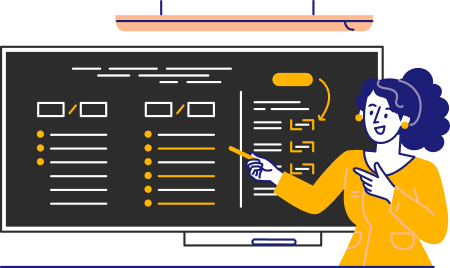
According to the U.S. Bureau of Labor Statistics, the employment of computer and information research scientists (including data analysts) is projected to grow 16 percent from 2018 to 2028. This is much faster than the average for other jobs!
Due to the high demand and high wages, it makes sense that people are flocking to apply for data analyst roles.
But that doesn’t mean you should be discouraged. Applying online to jobs can feel like applying in a black hole, and we know it sucks. It took one of our founders 77 job applications before he landed his first data analyst job at Geico, and the next job was much easier to get.
One issue with applying for data analytics roles is that these titles are not standardized across different companies. At one company, data analysts might spend their time building reports in Tableau, while at another, they might be writing machine learning models for production.
Because of this variability, it’s critical toanalyze your document to be sure to include the correct information in your data analytics resume. With this guide, you’ll put your best foot forward data analyst roles you’re seeking!

Show off your data analyst skills
First, you need to show you have the right abilities for the job! This means you need to accomplish two goals with the skills section of your data analyst resume. First, you have to be able to get past the automatic keyword filters in the applicant tracking system (ATS), which companies use to filter applicants. Next, you want to demonstrate your technical proficiency to the person reviewing your resume.
If you’re unsure which skills to include, we analyzed the data to learn which skills are most in demand for companies hiring data analysts.
These two goals are, unfortunately, mostly in opposition to each other. If your goal was to just get past the ATS, you’d list every skill to get your foot in the door:
Bad—avoid a long list of generic skills

The problem? This method is a big red flag to technical hiring managers. You should only include skills you’d be comfortable discussing in your data analyst interview. Plus, your skills section shouldn’t take up more than 20 percent of the page.
Any reasonable employer won’t expect you to know SAS, R, and Python. Instead, just list the technical skills that you’ve coded in before. And avoid including a skill like “data mining” or “data analysis” since a technical hiring manager knows these are just blanket terms that don’t mean much. Instead of “data mining,” list actual techniques you’ve used, like “decision trees” or “logistic regressions.”
But even when narrowing it down, sometimes your skills list looks cluttered and hard to read. Never fear; there are multiple ways to organize your skills section! For starters, you can list your skills by how proficient you are with them (“Advanced” vs. “Familiar,” for example). Alternatively, you can list your skills by skill type. You can even mention the years of experience you have with each tool.
For programming languages, mention the libraries and frameworks you use for data visualization and manipulation in that programming language.
Good—specific skills and modeling techniques


Your data analyst objective
Most of the time, you don’t need to include a resume objective or resume summary; a mistake many data analysts make. If a resume summary or objective doesn’t add value to your application, it’s okay to leave it out.
Here’s a sample data analyst resume objective that you would want to leave off of your resume:
Bad—uninformative resume objective

Why leave this off? It’s redundant. Suppose you already demonstrate in your resume that you used tools like Python and SQL to turn data into actionable insights. In that case, your objective doesn’t tell the person reviewing your resume any new information.
When to include a resume objective
- You’re undergoing a career change. You can say something like, “After 4 years of working in operations, I am now looking to leverage my expertise in turning data into insights as a data analyst.”
- You have a specific interest in a given role or company that makes you an especially strong candidate. For example, “Reading Match.com’s data blog ignited my pursuit of a career in data analytics, and I want to further contribute to the data-driven culture at the company.”
Summaries are similar, but they’re for candidates with over 10 years of experience and can include more personal achievements. There isn’t much difference between a resume summary or an objective; all you need to know is when you should include them.

Data analyst resume format
Here are some quick tips for formatting your data analytics resume:
- Keep it to one page.
- Break up bullet points into small, consumable pieces of information.
- Don’t refer to yourself with “I” or “we,” as it takes up room and looks unprofessional.
- Double, triple, and quadruple-check your grammar and spelling. One error can send your resume into the “no” pile!
- Each bullet point on your resume should be a self-contained, complete thought.
When a hiring manager reviews 50+ resumes for a given role, they quickly look for reasons to say “no.” By using these resume-formatting tips, you make it easier for the hiring manager to see your worth and ask you for an interview, getting you one step closer to a job.

Contact information
Of all the places to make an error, your contact information is the worst place to have it happen. One of our team members recounted their early days out of college as a data analyst. When they were applying for jobs, they accidentally wrote the wrong email address on their resume for seven different positions.
Even if they were perfectly qualified for the role, there was no way to contact them because of a minor mistake. So believe us when we say you need to triple-check this section for any spelling, grammar, or link errors.
As part of your contact information, you should include your name and the role you’re applying for (even if it’s not your current role).
You don’t need to include your full address in this section, but you should list your city and zip code. You also need your phone number just in case your employer prefers that method.
Finally, include a link to your LinkedIn profile and anything else that might convey why you’re a great data analyst. If you have an active Github, include a link to that. If you do a lot of Kaggle contests, include a link to your profile. Have a personal blog where you talk about election data? Be sure to include a link.


Data analyst projects for your resume
If you’re entry-level and looking for your first full-time role, including projects on your data analyst resume is an absolute must. However, the more work experience you get, the more projects should become less critical. By the time you have four-plus years of experience in the field, you should only include a project of which you’re exceptionally proud.
What projects should you list? Anything where you identified (or were given) a problem and you used data to come up with an answer to that problem. It’s okay if it’s a class project, but it’s even better if you took the initiative yourself.
If you don’t have any such projects, now is the time to work on some. Do you have a question you’ve never answered? An experiment you’ve been longing to try? Think of a way to gather and analyze data to sate your curiosity.
Here’s an example: one of our founders had a hunch that the major job boards (Indeed, Glassdoor, and LinkedIn) essentially had the same jobs for data science roles. So, he manually collected data, analyzed it, and wrote about it to determine the best job board for data scientists.
The projects you include don’t need to be exhaustive or ground-breaking. Employers just want to see that you can ask a question, use data to answer it, and present your findings reasonably and clearly.
Good—show you can answer your own questions with data

When talking about your projects, here’s how you should frame what you did:
- Clearly state the question you were answering or the problem you were trying to solve
- Show what tools or languages you used to solve the problem
- State the impact of the work you did
Your projects section is also an opportunity to provide more context around the programming languages and libraries you listed in your “skills” section.

Education
Like the “projects” section, the education section of your resume will be longer for entry-level data analysts relative to more experienced data analysts. You’ll want to include relevant courses you took in school related to data analytics for entry-level data analysts.
Courses relevant to data analytics are any mathematics, statistics, programming, and economics classes you took. To be an effective data analyst, you need to apply the principles you learned in these classes to real-world problems and datasets.
For entry-level roles, include relevant classes you took in school

Regardless of your experience level, you should always mention the school you attended, what you majored in (including minors or certifications), and when you graduated. This would also be the place to list any boot camps or relevant online courses you may have taken in the field.
If your background is in academia, you can also list any publications you may have co-authored. Be sure to include the title of the magazine and a link to allow the hiring manager to read further if they’re interested.
Only mention your GPA on your resume if it’s something you want to highlight—generally, only list your GPA if you’re entry-level and obtained anything above a 3.0.

Work experience
You analyze data for a living, so you know that numbers count when it comes to information. So when you’re talking about your work experience, your goal should be to highlight your accomplishments using numbers and estimates.
The formula for talking about work experience
“Specific contribution to project mentioning specific tools and skills”
+
“quantitative impact of the project”
Example:
“Performed a customer cohort analysis using SQL and Excel and recommended an email campaign for one customer segment”
+
“that lifted monthly retention by 10%”
Enter your text here…
When discussing your work, especially if it was a team project, emphasize your specific contributions. For example, you may have made a product recommendation based on a previous analysis. You’d want to talk about that particular recommendation on your resume instead of the built feature.
When talking about the quantitative impact, it’s okay to talk about the project as a whole. Following the example above, it’d be impossible to tease out the value of your product recommendation versus the engineer’s impact who built the feature since it’s a team effort. You’d say the feature had a revenue impact of $X on your resume.
Data analysts work across many different teams and projects in a company, so it’s not always easy to tie your work to a revenue impact. Still, try estimating your contributions using metrics to make your resume stand out.
These can be very rough estimates; you just want to make it clear that you’ve contributed to positive outcomes for the businesses where you worked.
Ways to quantify the impact of your analytics work
- Improved customer conversion rate
- “Used Python and SQL to determine a specific change in the landing page, resulting in a 10% boost in free trial activation rate”
- Saved manual reporting time
- “Streamlined and automated a key business report in Tableau, saving the team 10 hours of reporting each week”
- Reduced costs
- “Used SQL and Excel to recommend ending contracts with worst-performing vendors, resulting in a costs savings of $100,000 annually”
- Built data visualizations to help executives
- “Built data visualizations in Excel to demonstrate the efficacy of marketing plan, resulting in the close of a $1.3M Series A”
- Improved customer retention
- “Determined through analysis in Python that emailing customers who had been inactive for 7 days resulted in a retention improvement of 7 basis points”
- Improved business-specific KPI like time-to-hire
- “Identified procedural areas of improvement in hiring data to improve the time-to-hire for key roles by 11 days”
- Improved customer satisfaction
- “Used SQL and Excel to identify common complaints amongst new customers, leading to changes that improved new customer satisfaction by 14%”
When formatting your work experience, always list your most recent work at the top of your resume and list your other positions in reverse-chronological order.
Just to hammer home our point even further, here’s an example of the same work experience. One is stated in a quantitative impact, and one is not.
Bad—no quantitative impact

Good—quantitative impact


Tailor your resume for each job
For each role to which you apply, make minor edits to your resume based on the data analyst job description. Fortunately, you don’t have to completely rewrite your resume; just a few tweaks will do.
For example, let’s say you’ve done projects in both Python and R, and your resume heavily leans into your Python experience. If you apply to a job that mentions R, you should change your resume to discuss your R experience.
Similarly, if you have specific projects that relate to the job you’re applying for, include those projects. If you’re applying for a marketing data analyst role and have experience building marketing mix models, your application will become significantly stronger by mentioning those mix models.
Let’s say you’re applying to this job:

This seems like a heavy data visualization role. Instead of mentioning predictive modeling, talk extensively about your experience building robust data visualization in Tableau.
Change this:

To this:

How to Write an Effective Data Analyst Resume
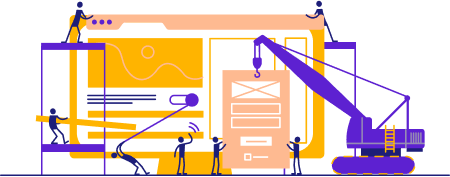
Here are the major takeaways you should keep in mind when writing a professional resume:
- Keep it to one page and proofread, proofread, proofread.
- For an entry-level role, mention any math/stats/econ/programming classes you took in college.
- Otherwise, don’t let your education section take up a lot of space.
- You don’t need a summary or objective section on your resume unless you’re undergoing a career change or have over 10 years of experience.
- Only include skills on your resume for which you’d be comfortable being interviewed.
- Mention your specific contributions and quantify the overall project’s impact on the business.
By following this guide, you’ll be able to quickly and convincingly make the case that you’re a great fit for the data analyst role for which you’re applying.
Applying for jobs isn’t easy, but you’ve taken a huge first step toward landing that dream job. Now all that’s left is to write, double-check your resume for errors, and submit it to your dream job!




